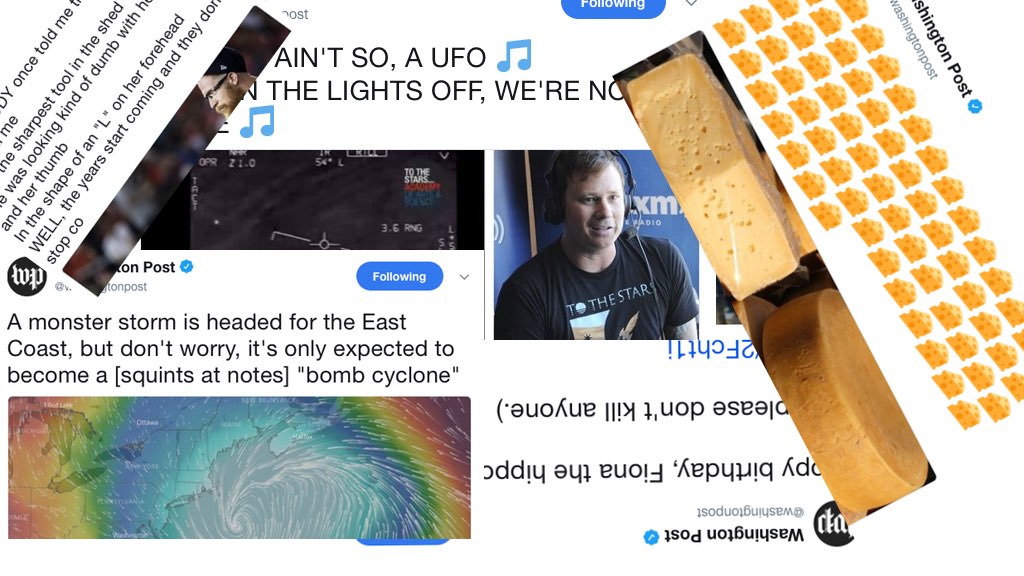There is no shortage of ideas about how news organizations should promote their work on Twitter. They should deploy an authentic voice and use relevant hashtags. They should use native photos and video. They should encourage reporters to chat with readers on the platform.
Or, like the Washington Post did last month, they should tweet out the lyrics to a Smash Mouth song.
🗣️ SOMEBODY once told me the world is gonna roll me
I ain't the sharpest tool in the shed
She was looking kind of dumb with her finger and her thumb
In the shape of an "L" on her forehead
WELL, the years start coming and they don't stop co https://t.co/g2ze2eB3V2— The Washington Post (@washingtonpost) July 9, 2018
This tweet isn’t as bizarre as it might seem. Real quick: The 1999 hockey-barn anthem has become a meme all these years later (kind of hard to explain, but here, have at it), and the story it promotes is about how Nationals pitcher Sean Doolittle, with Smash Mouth’s help, publicized the fact that he’d been chosen for the 2018 MLB All-Star team. But selling that article with the lyrics of the song? There’s a lot of Ric Sanchez in that decision.
Sanchez is a 25-year-old social media producer for the Washington Post and a member of its “core social” team, which runs the publication’s Facebook, Twitter, and Instagram accounts from 6 AM to 7 PM daily. Conditions on July 9 were amenable to a monster helping of Sanchez: “That happened to be a day I remember everybody was not at their desks,” he says. “I thought the worst that was going happen is people would be like, ‘So that was weird.’ ”
The tweet did earn that reaction, but it also spurred a replies thread that’s several hundred times nicer than you’d expect comments to be on anything the Post publishes in this polarized era: From “this is why you are my fav local paper” to “woodward and bernstein should hang their heads in shame that their award-winning dogged journalism has been topped by a smash mouth song lyric,” as Eireann Dolan, who’s married to Doolittle, wrote.
A monster storm is headed for the East Coast, but don't worry, it's only expected to become a [squints at notes] "bomb cyclone" https://t.co/tLjbbRCQiD
— The Washington Post (@washingtonpost) January 2, 2018
“That’s Ric’s weapon, that he understands the internet better than most I’ve ever met,” says Mark W. Smith, the Post’s deputy audience editor and Sanchez’s boss. “In this job we’re too quick to ask people to leave that at the door.”
The core social group—its other members are Travis Lyles, Christine Loman, and Jennifer Hassan, who works from London— often workshops tweets using the team-messaging service Slack, but, Smith says, training reporters and editors to write better headlines helps ease that sense of “what should we do with this?”: “When I got here, Mark was doing a training for a lot of reporters that when you write a headline it should sound good on Facebook or Twitter,” Sanchez says. “So honestly most of our tweets are a version of whatever headline is on the story.”
Super-dry headlines might occasion a back-and-forth with the original writer and editor, as well as a skull session with core social members. But talk to Post reporters and you’ll hear one theme repeat: You can always tell a Ric tweet. So yes, let’s discuss the cheese one.
🧀🧀🧀🧀🧀🧀🧀🧀🧀🧀🧀🧀🧀🧀🧀🧀🧀🧀🧀🧀🧀🧀🧀🧀🧀🧀🧀🧀🧀🧀🧀🧀🧀🧀🧀🧀🧀🧀 🧀🧀🧀🧀🧀🧀🧀🧀🧀🧀🧀🧀🧀🧀🧀🧀🧀🧀🧀🧀🧀🧀🧀🧀🧀 https://t.co/V6odrJLV9D
— The Washington Post (@washingtonpost) June 28, 2018
It’s for a Caitlin Dewey story that discusses the economic conditions that led to the US stockpiling 1.39 billion pounds of cheese. The tweet is 63 cheese emoji followed by a link. “The click-through on the cheese emoji tweet was actually good,” Smith says. “Literally I was like, this story’s about a lot of cheese, let’s put a lot of cheese there,” Sanchez says.
🎵 SAY IT AIN'T SO, A UFO 🎵
🎵 TURN THE LIGHTS OFF, WE'RE NOT ALONE 🎵https://t.co/BIeYtqvJ79— The Washington Post (@washingtonpost) May 30, 2018
Sanchez says he usually limits himself to one wacky tweet a week. But as fun as it is to catalog the more out-there examples of its work, the leeway he gets from the Post evinces an evolution in how the organization expresses itself to the nearly 13 million people who follow it on Twitter. (Smith chalks it up to the Post‘s “culture of experimentation”: “We try to not say no to things.”) The unusual tweets “can cut through what most people understand as the institutional voice of the Washington Post,” Sanchez says.
They’re also opportunities for the paper to connect with those readers, through what Smith calls “surprise and delight moments.” The Post‘s team often replies to readers on Twitter as a way to answer questions a lot of people have asked, or just to amplify a good comment:
More of a "WAHH," as in Waluigi. pic.twitter.com/iI7emrgCWO
— The Washington Post (@washingtonpost) June 27, 2018
Those conversations can be fraught. “The team knows when something might be perceived sensitively,” Smith says. “If we’re jumping in to say why we covered something, that’s something that we’d check with editors first.”
The Post has cut back on the frequency with which it posts on Facebook. This isn’t unusual: Many publishers, including Washingtonian, have seen their referrals from that network shrink in recent months (the Post declined to say whether it was the case there), and while Instagram is a terrific platform, lots of outlets view it as almost a standalone publication, since it doesn’t tend to drive a lot of direct web traffic.
“People drop in on Facebook a couple times a day,” Smith says. “Twitter is more of a firehose. You’ve got to be really aware of what the conversation is at any time.”
Happy birthday, Fiona the hippo!
(Now please don't kill anyone.)https://t.co/oqbsVRGaxJ pic.twitter.com/0HpeAxhDGz
— The Washington Post (@washingtonpost) January 24, 2018
The Post just happens to make room for whimsy once in a while among the hundreds of daily tweets that feed that conversation. (One of Twitter’s strengths relative to other platforms is that it’s a weird tool that rewards weirdness, which understandably scares the hell out of many people charged with guarding publications’ identity and credibility.) So, to close, let’s talk about how the “ORBS” tweet happened. It referred to a story that was plenty strange to begin with, and Smith says the tweet flogging it was another Sanchez idea, which Loman blasted out. Sanchez’s Slack message that day was “i say this 100 percent seriously: we should just tweet this story with ‘ORBS.’”
“And then Christine did,” Smith says.
— The Washington Post (@washingtonpost) July 18, 2018



















